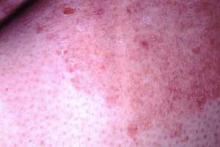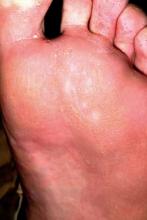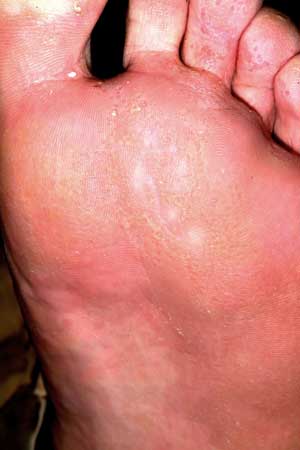User login
HISTORY
A 36-year-old man self-refers to dermatology with two complaints. The more serious is the very itchy rash present on his back for several weeks. He has tried treating it with several OTC creams, including 1% hydrocortisone, triple-antibiotic, and diphenhydramine. The hydrocortisone cream provided some short-term relief from the itching, but over time, the rash has grown and become more symptomatic.
The condition affecting his feet has caused little in the way of symptoms. However, it has caused quite a stir in the family; every night, on returning from work, the patient removes his shoes, releasing a pervasive, highly objectionable odor. It didn’t take long for his family to insist that he remove his shoes in the backyard, where he is to remain until the odor clears a bit. The patient is also concerned about a “spongy” feeling the soles of his feet have acquired along with the odor. Neither symptom has responded to topical OTC products, such as athlete’s foot cream (tonaftate) and spray or calamine lotion; lengthy soaks in bleach-containing water have not helped, either.
The patient claims to be in reasonably good health. He is working in a new job, repairing air conditioners on the roofs of commercial buildings.
EXAMINATION
An impressive rash is seen on the patient’s upper back, extending from the hairline to mid-back, with a long, curved papulosquamous border on its inferior aspect. Aside from the soles of his feet, the only other skin abnormality is a faintly erythematous rash around the rims of both feet. KOH examination reveals these patches to be loaded with fungal elements.
Both soles have a spongy, whitish look, with focal areas of punctuate crateriform and arciform superficial loss of the outer keratin layer of skin. But there is no erythema or no tenderness on palpation.
DISCUSSION
Daily exposure to constant sweat and heat is responsible for all of this man’s skin problems, although there are two different conditions involved. Tinea corporis is the explanation for the extensive rash on his upper back. However, the repeated application of topical steroids is the likely explanation for the astonishing size and scope of the rash, since steroids (even 1% hydrocortisone!) blunt the body’s immune response to this superficial dermatophytosis. As is often the case, this outbreak was so large it was hard to see. Heat and sweat might be the immediate cause, but what about the source?
The fungal organisms on the rims of his feet, probably present asymptomatically (and unrecognized) for years, provide a clue to the patient’s susceptibility to this class of organisms. Trichophyton rubrum is by far the most common cause; given enough heat, sweat, and steroids, it can easily spread to other areas of the body.
Now to the feet, where antifungal cream (tolnaftate) and bleach had no good effect: The name given to this common condition is pitted keratolysis (PK). PK is caused by several bacterial organisms that thrive in this hot, humid environment, feeding on the keratin layer and producing the pattern seen. The most common bacteria involved is Kytococcus sedentarius, but all are part of normal gram-positive flora and are also responsible for the powerful odor noted in many—though not all—cases. Since the organism feeds on lifeless keratin and causes no inflammatory response or symptoms, PK is not really an “infection” in the sense that we normally use this word.
TREATMENT AND PROGNOSIS
PK is successfully treated with a combination of topically applied antiperspirant (such as prescription-strength aluminum chloride, or OTC antiperspirant with aluminum chorhydroxide) and topical clindamycin 2% solution. Though an endpoint is unlikely with these treatments, control is possible.
The same could be said for the steroid-exacerbated tinea corporis on the patient’s back, since the conditions that lead to its appearance will still be present. Given the severity and symptomatic nature of this eruption, I gave the patient oral terbinafine (250 mg bid for 10 days) plus topical econazole cream (bid until the rash is clear). For maintenance, he’ll use OTC ketoconazole shampoo as a body wash, to reduce the numbers of these organisms.
During the winter, both of these conditions will abate sharply, only to reappear when the weather heats up in the spring. Patient education is necessary as to this aspect of both conditions, including their prognoses.
For the provider, this case highlights, once again, the difficulty that dermatologic complaints present. PK, for example, looks very much as though it should “have a name,” but neither its name nor its origins nor remedies will be clear if the requisite time has not been spent learning about it in advance of its inevitable sighting.
HISTORY
A 36-year-old man self-refers to dermatology with two complaints. The more serious is the very itchy rash present on his back for several weeks. He has tried treating it with several OTC creams, including 1% hydrocortisone, triple-antibiotic, and diphenhydramine. The hydrocortisone cream provided some short-term relief from the itching, but over time, the rash has grown and become more symptomatic.
The condition affecting his feet has caused little in the way of symptoms. However, it has caused quite a stir in the family; every night, on returning from work, the patient removes his shoes, releasing a pervasive, highly objectionable odor. It didn’t take long for his family to insist that he remove his shoes in the backyard, where he is to remain until the odor clears a bit. The patient is also concerned about a “spongy” feeling the soles of his feet have acquired along with the odor. Neither symptom has responded to topical OTC products, such as athlete’s foot cream (tonaftate) and spray or calamine lotion; lengthy soaks in bleach-containing water have not helped, either.
The patient claims to be in reasonably good health. He is working in a new job, repairing air conditioners on the roofs of commercial buildings.
EXAMINATION
An impressive rash is seen on the patient’s upper back, extending from the hairline to mid-back, with a long, curved papulosquamous border on its inferior aspect. Aside from the soles of his feet, the only other skin abnormality is a faintly erythematous rash around the rims of both feet. KOH examination reveals these patches to be loaded with fungal elements.
Both soles have a spongy, whitish look, with focal areas of punctuate crateriform and arciform superficial loss of the outer keratin layer of skin. But there is no erythema or no tenderness on palpation.
DISCUSSION
Daily exposure to constant sweat and heat is responsible for all of this man’s skin problems, although there are two different conditions involved. Tinea corporis is the explanation for the extensive rash on his upper back. However, the repeated application of topical steroids is the likely explanation for the astonishing size and scope of the rash, since steroids (even 1% hydrocortisone!) blunt the body’s immune response to this superficial dermatophytosis. As is often the case, this outbreak was so large it was hard to see. Heat and sweat might be the immediate cause, but what about the source?
The fungal organisms on the rims of his feet, probably present asymptomatically (and unrecognized) for years, provide a clue to the patient’s susceptibility to this class of organisms. Trichophyton rubrum is by far the most common cause; given enough heat, sweat, and steroids, it can easily spread to other areas of the body.
Now to the feet, where antifungal cream (tolnaftate) and bleach had no good effect: The name given to this common condition is pitted keratolysis (PK). PK is caused by several bacterial organisms that thrive in this hot, humid environment, feeding on the keratin layer and producing the pattern seen. The most common bacteria involved is Kytococcus sedentarius, but all are part of normal gram-positive flora and are also responsible for the powerful odor noted in many—though not all—cases. Since the organism feeds on lifeless keratin and causes no inflammatory response or symptoms, PK is not really an “infection” in the sense that we normally use this word.
TREATMENT AND PROGNOSIS
PK is successfully treated with a combination of topically applied antiperspirant (such as prescription-strength aluminum chloride, or OTC antiperspirant with aluminum chorhydroxide) and topical clindamycin 2% solution. Though an endpoint is unlikely with these treatments, control is possible.
The same could be said for the steroid-exacerbated tinea corporis on the patient’s back, since the conditions that lead to its appearance will still be present. Given the severity and symptomatic nature of this eruption, I gave the patient oral terbinafine (250 mg bid for 10 days) plus topical econazole cream (bid until the rash is clear). For maintenance, he’ll use OTC ketoconazole shampoo as a body wash, to reduce the numbers of these organisms.
During the winter, both of these conditions will abate sharply, only to reappear when the weather heats up in the spring. Patient education is necessary as to this aspect of both conditions, including their prognoses.
For the provider, this case highlights, once again, the difficulty that dermatologic complaints present. PK, for example, looks very much as though it should “have a name,” but neither its name nor its origins nor remedies will be clear if the requisite time has not been spent learning about it in advance of its inevitable sighting.
HISTORY
A 36-year-old man self-refers to dermatology with two complaints. The more serious is the very itchy rash present on his back for several weeks. He has tried treating it with several OTC creams, including 1% hydrocortisone, triple-antibiotic, and diphenhydramine. The hydrocortisone cream provided some short-term relief from the itching, but over time, the rash has grown and become more symptomatic.
The condition affecting his feet has caused little in the way of symptoms. However, it has caused quite a stir in the family; every night, on returning from work, the patient removes his shoes, releasing a pervasive, highly objectionable odor. It didn’t take long for his family to insist that he remove his shoes in the backyard, where he is to remain until the odor clears a bit. The patient is also concerned about a “spongy” feeling the soles of his feet have acquired along with the odor. Neither symptom has responded to topical OTC products, such as athlete’s foot cream (tonaftate) and spray or calamine lotion; lengthy soaks in bleach-containing water have not helped, either.
The patient claims to be in reasonably good health. He is working in a new job, repairing air conditioners on the roofs of commercial buildings.
EXAMINATION
An impressive rash is seen on the patient’s upper back, extending from the hairline to mid-back, with a long, curved papulosquamous border on its inferior aspect. Aside from the soles of his feet, the only other skin abnormality is a faintly erythematous rash around the rims of both feet. KOH examination reveals these patches to be loaded with fungal elements.
Both soles have a spongy, whitish look, with focal areas of punctuate crateriform and arciform superficial loss of the outer keratin layer of skin. But there is no erythema or no tenderness on palpation.
DISCUSSION
Daily exposure to constant sweat and heat is responsible for all of this man’s skin problems, although there are two different conditions involved. Tinea corporis is the explanation for the extensive rash on his upper back. However, the repeated application of topical steroids is the likely explanation for the astonishing size and scope of the rash, since steroids (even 1% hydrocortisone!) blunt the body’s immune response to this superficial dermatophytosis. As is often the case, this outbreak was so large it was hard to see. Heat and sweat might be the immediate cause, but what about the source?
The fungal organisms on the rims of his feet, probably present asymptomatically (and unrecognized) for years, provide a clue to the patient’s susceptibility to this class of organisms. Trichophyton rubrum is by far the most common cause; given enough heat, sweat, and steroids, it can easily spread to other areas of the body.
Now to the feet, where antifungal cream (tolnaftate) and bleach had no good effect: The name given to this common condition is pitted keratolysis (PK). PK is caused by several bacterial organisms that thrive in this hot, humid environment, feeding on the keratin layer and producing the pattern seen. The most common bacteria involved is Kytococcus sedentarius, but all are part of normal gram-positive flora and are also responsible for the powerful odor noted in many—though not all—cases. Since the organism feeds on lifeless keratin and causes no inflammatory response or symptoms, PK is not really an “infection” in the sense that we normally use this word.
TREATMENT AND PROGNOSIS
PK is successfully treated with a combination of topically applied antiperspirant (such as prescription-strength aluminum chloride, or OTC antiperspirant with aluminum chorhydroxide) and topical clindamycin 2% solution. Though an endpoint is unlikely with these treatments, control is possible.
The same could be said for the steroid-exacerbated tinea corporis on the patient’s back, since the conditions that lead to its appearance will still be present. Given the severity and symptomatic nature of this eruption, I gave the patient oral terbinafine (250 mg bid for 10 days) plus topical econazole cream (bid until the rash is clear). For maintenance, he’ll use OTC ketoconazole shampoo as a body wash, to reduce the numbers of these organisms.
During the winter, both of these conditions will abate sharply, only to reappear when the weather heats up in the spring. Patient education is necessary as to this aspect of both conditions, including their prognoses.
For the provider, this case highlights, once again, the difficulty that dermatologic complaints present. PK, for example, looks very much as though it should “have a name,” but neither its name nor its origins nor remedies will be clear if the requisite time has not been spent learning about it in advance of its inevitable sighting.


